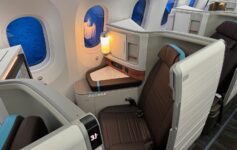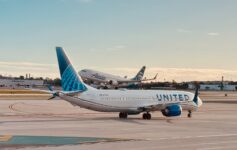
While Boeing continues to lose credibility, this time via a damning report from the National Transportation Safety Board (NTSB), the news could have been much worse. Indeed, quality control issues are much easier to overcome than structural engineering deficiencies.
NTSB 737 MAX 9 Preliminary Report: Installation Error Rather Than Structural Deficiency
The NTSB just published its preliminary report concerning the Boeing 737 MAX 9 incident on Alaska Airlines 1282 on January 5, 2024. There was some concern that the plugged emergency exit door suddenly detached from the aircraft in-flight due to a structural engineering defect of the aircraft.
It appears that is not the case. Instead, the NTSB outlined the following timeline:
- March 24, 2023 – Spirit AeroSystems manufactures the door plug of the 737 MAX 9 in Malaysia
- May 10, 2023 – Door plug sent to Spirit AeroSystems in Wichita, Kansas
- August 20, 2023 – Door plug installed on fuselage, shipped to Boeing
- September 1, 2023 – Rivet damage discovered on the edge frame around left door plug, leading to the removal of bolts for repairs
The paper trail stops there, but it was determined that the bolts were never re-installed before the aircraft was sent to Alaska Airlines.
That is a damning lack of oversight and quality control. But it is not like the bolts just popped off midair because of the aircraft design. Instead, they were simply not installed…and that sort of issue is much easier to correct than any structural issue.
As Emirates’ President Sir Tim Clark warned, Boeing has virtually no more room for error. Not only is this a humbling and teaching moment, but Boeing must institute redundant quality control checks throughout the supply chain process if it hopes to maintain what little trust is left.
But this is possible: this is doable. And for that, I can only imagine that Boeing is breathing a huge sigh of relief.
CONCLUSION
There is no excuse for failing to re-install bolts on an aircraft and for others to fail to notice this. But Boeing can be happy that the NTSB found human error in installation rather than a structural defect that could have grounded the entire program once again.
While this does not mean the 737 MAX 7 or MAX 10 will be certified, I think this report makes such certification more likely. The only unanswered question is why United Airlines and Alaska found loose bolts on some aircraft: was this also a sloppy installation job as well or is there something else going on?




Agreed 100%
This clown is responsible for possibly hundreds of billions in lost revenues and stock values. The poor schmuck will probably be protected by his union sadly.
The unreleased paperwork would be interesting to read.
But yes, this is “good news” overall for the company long term.
Blame the worker instead of management pushing high production levels with a large number of new employees. Also why are there two defect tracking systems?
Boeing CEO Dennis Muilenburg whose cost cutting at Boeing led to the deaths of 364 air passengers resulting in billions of dollars of losses was given a bonus of 80 million upon leaving.
Imagine how much more he would have gotten if he was in a union, I suppose? 🙂
I keep wondering why he and other executives aren’t in a federal prison for what they did.
In the case of the worker, it’s possible that this was an oversight due to bad paperwork as some have said rather than laziness. As someone who knows “the game”, I never shirk safety procedures to speed things up if I’m paid by the hour. Why should I put my neck on the line to save the company money and time particularly if it’s a safety issue?
Usually the result of a SERIES of human errors. Someone wants to AVOID a lot of “needless” paperwork and inspection, to make deadlines. So they classify the job in such a way it doesn’t need inspection. THEN the job of reinstalling the door doesn’t get finished by one shift, and gets taken over by another. Shift #2 thinks the work is already done due to ambiguous wording at handover. So they start closing up the panels. Safety regulations are written in blood, because humans make mistakes. Pretending we don’t make mistakes, and don’t NEED inspections or safety regs, is what gets people killed. Or in this case, gets Boeing put in the doghouse.
@Vicente … +1 .
Matt, I think you meant to write: Spirit AeroSystems manufactures the door plugs of the 737 MAX 9 in Malaysia, not the fuselage. The fuselage is manufactured by Spirt AeroSystems in Wichita, KS.
Thanks Tee Jay. I’ve clarified that.
To hear the Max is an unsafe aircraft is the rambling of a moron. No structural design flaws, no complex system failure, just someone who failed a simple Task. Years back working as an auto mechanic, someone at the dealership installed brake disc pads backwards resulting in metal to metal contact with the brake disc rotor. Human failure, not product failure.
What good is a flawless super-safe design if the people putting it together are unqualified? Or the quality procedures is garbage? End result = doors blown out of the sky
Now imagine a GM plant forgetting to install door pins causing people to fall out. In the end, it’s the manufacturer’s fault.
Giving Boeing a free pass here is precisely the wrong conclusion to come to.
There will be zero change if they bear no responsibility for the abysmal supply chain / safety failures that appear to be endemic at Boeing.
I want to see accountability and transparency on steroids at Boeing right now. And I don’t want to see or hear even the slightest hint of a ‘no big deal, people will forget this’ attitude from their execs.
Back when Boeing decided to move HQ out of Seattle, I was concerned that what it was doing to become more attractive to politicians and military officials in DC was going to come with additional risk to hits in quality control. Actually, I was concerned about how Boeing’s various developments starting during the Clinton Admin had already sent Boeing down a road where focus on quality control was headed toward being sacrificed.
Between management’s merger pursuits and a focus on sales and marketing at the expense of a focus on and respect for legacy in-house engineering, internally-maintained supply chain, and quality control done by its own, some things were bound to give with the company’s drive for margins in the way it was done.
I had some of my bread buttered by Boeing in the DC area as well as by some other defense contractors/suppliers that got cozy with Boeing, but it was with their work in DC and VA and had basically nothing to do with its engineering and manufacturing operations.
I wouldn’t fully agree. As another member of the DIB, I’d say they’re the actions in DC and Crystal City are very much related back to the goings on in Seattle. There may not be a 1:1 interaction between commercial and public sector, but ultimately leadership across both orgs/companies talk and eventually roll up to a handful of people across everything. There’s a ton of “what’s good for the goose is good for the gander”. “Efficiencies” noted in one sector absolutely become lessons learned and applied across the others. This lack of QA/QC doesn’t just spring up out of nowhere. It snowballs and is summarily ignored by complacent management that have realized that it’s okay to pencil-whip/gundeck paperwork to maintain LRIP/FRP of airframes or whatever else is being produced
Oh great so we have a “clear timeline” for the MAX return to service. Let’s hear it for “transparency”, “accountabilty” and of course, executive bonuses. The question nobody is asking is: What OTHER bolts have been left out, not tightened, and got past factory QA, Alaska pre-delivery acceptance, and line maintenance. Sir Tim is right ! Boeing cannot tolerate another major safety incident. The FAA, were it doing it’s job, wouild require that every plane be put thru D-Check to make sure everything was “safe”. But they won’t.
I’m just curious how in the world did it stay in place for (what did they say…) 150 more flights before blowing out.